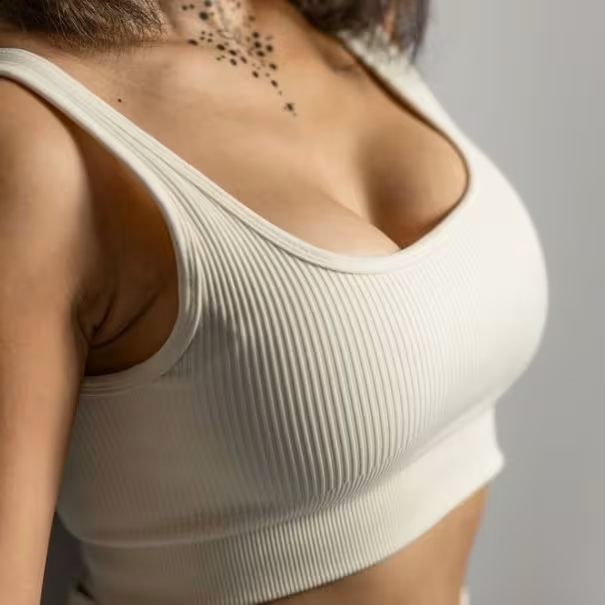
Many women have a complicated relationship with their breasts. From size and shape to the wrong bra size, there’s often more to them than meets the eye. Whether you’re considering breast plastic surgery or just want to learn more about your body, here are five things you didn’t know about your breasts that can help keep them healthy and strong.
We’ll explore the different types of nipple shapes, average breast sizes, how to find the right bra size for you, the importance of regular breast exams, and the risks associated with breast cancer. Knowing more about your breasts can help you feel more confident and comfortable in your own skin!
How Heavy Are Breasts? Understanding Breast Weight and Its Health Impact
Breasts can weigh quite a lot, especially for those considering breast reduction. For example, a pair of D-cup size breasts can weigh up to 23 pounds—similar to the weight of a baby. On average, breasts make up about 5% of a woman’s total body fat. This weight can cause discomfort, especially if the breasts are larger, which is why it’s crucial to try sizers before deciding on breast augmentation.
Heavy breasts often contribute to health issues such as chronic neck, shoulder, and back pain, poor posture, and skin irritation due to friction. If you’re experiencing significant discomfort, a supportive, well-fitted bra can help alleviate some strain, but for long-term relief, breast reduction surgery may be an option worth considering.
A breast common myth is that breast size changes with weight gain, but this isn’t always true. Breasts are primarily composed of fatty tissue, and their weight tends to remain stable over time, even after significant changes like pregnancy.

Is the weight of your breasts affecting your comfort?
Contact Dr. Vitenas today for a consultation to discuss the right solution for you.
Is Bigger Always Better? Personalized Breast Size Evaluation, Implants, and Their Impact.
Bigger breasts are not always better when it comes to beauty standards. Throughout history, small breasts were often preferred, such as in ancient Rome, Greece, and Egypt. Today, many women choose breast augmentation to enhance their bust size, but there is also a trend towards smaller, natural-looking implants.
Key Factors to Consider Before Breast Augmentation
- Body Type and Lifestyle: The ideal implant size depends on your body type, age, and lifestyle. What works for one person may not work for another.
- Risks: Breast augmentation carries risks, such as:
- Bleeding or Infection: Complications that can occur during or after surgery.
- Capsular Contracture: Scar tissue forming around the implant, which can cause discomfort.
- Long-Term Health: Consider any potential long-term effects, such as changes in hormone levels that may increase health risks.
Finding the Right Size for You
- Understand Average Sizes: Breast sizes range from A-cup to DD-cup, and finding what fits your body best is crucial for a natural result.
- Lifestyle Impact: Think about how a new breast size might affect daily life, including:
- Clothing Choices: How different sizes might change the way your clothes fit.
- Physical Activity: Larger breasts may impact exercise routines or comfort during physical activities.
Breast augmentation is a personal decision, and what matters most is choosing what makes you feel confident and comfortable
Uneven Breasts Explained: Causes, Commonality, and How to Address It
Asymmetrical breasts are very common, with over 60% of women having uneven breasts. Differences in breast size are often due to:
- Connective and Breast Tissue: Natural variations in connective tissue (which supports firmness) and breast tissue (which gives shape) can cause one breast to be larger than the other.
- Hormonal Fluctuations: Hormone changes can also affect breast size over time, causing differences.
- Genetics or Trauma: Some asymmetry is due to genetics or past injuries affecting breast growth.
When to Be Concerned
- Mild differences in breast size are usually nothing to worry about.
- If asymmetry causes pain or significant discomfort, it’s worth consulting with a medical professional.
Solutions for Uneven Breasts
If you feel self-conscious or experience discomfort due to uneven breasts, Breast Augmentation may help improve symmetry. Dr. Vitenas can work with you to find the best technique to restore balance and help you feel more comfortable in your body, schedule a consultation today!
PATIENT TESTIMONIALS
Real Stories of Satisfied Boob Job Results
“I had a really great experience with Dr. Vitenas .I had a breast
augmentation, and could not be happier with the results! He is great,
his office staff is great, and they all made me feel very comfortable.
Dr. Vitenas answered every question that I had, and is clearly very
knowledgeable about this particular procedure. He made great
recommendations, based on what I told him I hoped to accomplish, and my
results are fantastic!”
Real Patient Review
Activities and Habits That Cause Breast Sagging and How to Prevent It.
It’s important to be breast aware and understand how certain activities can impact the health of your breasts. While there are many ways to maintain healthy, firm breasts, some activities can increase the likelihood of sagging or cause discomfort.
Causes of Breast Sagging and How to Prevent It
The majority of women experience some degree of sagging, often due to common lifestyle habits. Here are the main contributors and how to counteract them:
- Wearing the Wrong Bra Size:
- Wearing an ill-fitting bra can fail to provide the necessary support, leading to sagging over time, especially for women with larger breasts.
- Prevention: Make sure you get fitted for the right bra size to ensure your breasts are adequately supported, especially during physical activities.
- Smoking:
- Smoking damages the elastin fibers and ligaments that help keep breasts firm, contributing significantly to sagging.
- Prevention: Quitting smoking will not only improve your overall health but also help maintain the elasticity of your breast tissue, reducing the likelihood of sagging.
- Exercising Without Proper Support:
- Physical activities, particularly high-impact exercises, can put stress on breast tissue, which contributes to sagging if unsupported.
- Prevention: Always wear a well-fitted, supportive sports bra while working out to reduce strain and minimize movement.
What to Do if Sagging Affects Your Confidence
Breast sagging is natural over time and is generally not something to be concerned about unless it causes significant discomfort or impacts your confidence. If sagging is affecting how you feel about your body, surgical options like augmentation can help restore firmness and provide a more youthful shape.
A consultation with an experienced surgeon, such as Dr. Vitenas, can help determine the best approach for your specific goals.
Breast Cancer Awareness: Risks for Both Men and Women
Breast cancer affects both men and women, though it is much more common in women. Understanding the risk factors and recognizing early symptoms are crucial for timely detection.
Key Risk Factors
- Family History: A family history of breast cancer or genetic mutations (BRCA1/BRCA2) increases risk.
- Lifestyle Factors: Obesity, smoking, and heavy alcohol use are significant contributors.
Symptoms to Watch For
Be aware of changes such as:
- Pain in the breast or nipple
- Nipple discharge or skin irritation
- Lumps or redness in the breast
Inflammatory Breast Cancer (IBC) is aggressive and may not cause a lump. Symptoms include redness, skin dimpling, and persistent itching. Seek medical help immediately if you notice these changes.
Early Detection Matters
Early detection can significantly improve outcomes. Women should schedule regular mammograms, and men should also be mindful of any changes. Regular checkups and self-exams are vital.
Expert Care and Guidance
Advances in medical care have improved detection and survival rates for breast cancer. If you’re concerned about breast health or need advice, Dr. Vitenas offers compassionate, expert consultations to guide you through every step.

Managing risk or addressing symptoms?
Proactive care is essential. Contact Dr. Vitenas to schedule your consultation today and take control of your breast health with confidence.
How Your Sleep Position Can Impact Breast Health and Shape
Your sleep position can significantly affect the health and shape of your breasts.
- Sleeping Face Down: Lying on your stomach puts excess pressure on breast tissue, leading to flattening, sagging, and discomfort over time.
- Sleeping on Your Side: Side sleeping is recommended as it minimizes pressure on breast tissue, helping maintain their natural shape.
Tips for Breast-Friendly Sleep
- Use a Soft Sleep Bra: Wearing a supportive bra at night can keep your breasts comfortably in place, especially if they are larger.
If you’re concerned about the appearance or health of your breasts, Dr. Vitenas offers professional consultations to explore personalized enhancement options.
Get your Breast Health check with Us!

One other thing to know about your breasts: you can easily change their size or shape with surgery. In Houston, Texas, Dr. Paul Vitenas is a board-certified plastic surgeon with over 30 years of experience, provides expert insights on breast health and surgical procedures. As one of Houston’s leading breast augmentation specialists, Dr. Vitenas has helped countless patients achieve their aesthetic goals safely and effectively. Recognized for his innovative techniques and commitment to personalized care, Dr. Vitenas has been named among America’s Top Plastic Surgeons.
He is a proud member of the American Society of Plastic Surgeons (ASPS) and the American College of Surgeons (FACS). His commitment to patient safety and satisfaction is reflected in his extensive professional qualifications and glowing patient testimonials.
To learn more, call 281-484-0088 to schedule a consultation today.


